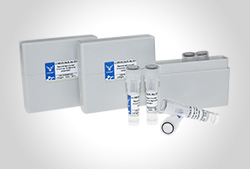重组蛋白

重组蛋白质是分析生物相互作用的有用工具。在研究实验室中使用了大量的重组蛋白质,包括商业蛋白质和在特定研究项目中生成的蛋白质。它们在许多应用中发挥着关键作用。
如果您正在寻找具有优良质量(验证的生物活性,较低的内毒素水平和高纯度)的重组蛋白质来支持您的研究,您来对地方了。
经过16多年的发展,j9九游会登录入口首页生物已经建立了从原核到真核的五大系统,用于表达重组蛋白质。我们拥有一系列蛋白质表达和纯化技术,包括基于杆状病毒外膜蛋白(OMP)的蛋白质表达技术,以及膜蛋白表达技术等。
产品特点
- 超过10,000种重组蛋白覆盖大多数基因/靶点;
- 5种表达系统,包括大肠杆菌(E.coli)、酵母、杆状病毒感染的昆虫细胞、哺乳动物细胞和体外大肠杆菌。而体外大肠杆菌表达系统是j9九游会登录入口首页生物的独特表达系统。与传统蛋白表达系统相比,体外大肠杆菌省略了许多过程,如质粒转化、细胞培养、收集、破碎和离心等,大大提高了工作效率。
- 多种标签,包括His、GST、Flag、MBP等。
- 广泛应用,包括抗原、细胞分析、结合分析/蛋白质相互作用、细胞培养-无血清培养基、药物相关研究、体外酶活性、ELISA标准及其原料、体内研究、质谱标准、蛋白芯片、SDS-PAGE控制、蛋白质结构分析(晶体/电子显微镜)。
- 多种物种,包括人类、小鼠、大鼠、兔子、豚鼠、鸡、猴子、猪等。
- 无动物副产品的动物源性重组蛋白质。j9九游会登录入口首页生物已开发出无动物副产品接触的重组蛋白质产品线。
重组蛋白目录
以下是所有重组蛋白的目录。您可以在目录中找到适合您研究的蛋白质,或在本网站头部的搜索框中搜索它们。
如果您找不到您需要的抗体,请查看j9九游会登录入口首页生物蛋白质定制服务。
通过选择目标名称的首字母浏览产品。
| 产品名称 | 货号 | 规格 |
|---|---|---|
| Recombinant Clostridium thermocellum Bifunctional protein FolD (folD) | CSB-YP385183DUT CSB-EP385183DUT CSB-BP385183DUT CSB-MP385183DUT CSB-EP385183DUT-B |
20μg/100μg/1mg(1mg*1 or 500ug*2) |
| Recombinant Clostridium thermocellum 5-methylthioadenosine/S-adenosylhomocysteine deaminase (mtaD) | CSB-YP385184DUT CSB-EP385184DUT CSB-BP385184DUT CSB-MP385184DUT CSB-EP385184DUT-B |
20μg/100μg/1mg(1mg*1 or 500ug*2) |
| Recombinant Clostridium thermocellum Probable nicotinate-nucleotide adenylyltransferase (nadD) | CSB-YP385185DUT CSB-EP385185DUT CSB-BP385185DUT CSB-MP385185DUT CSB-EP385185DUT-B |
20μg/100μg/1mg(1mg*1 or 500ug*2) |
| Recombinant Clostridium thermocellum Nicotinate-nucleotide--dimethylbenzimidazole phosphoribosyltransferase (cobT) | CSB-YP385186DUT CSB-EP385186DUT CSB-BP385186DUT CSB-MP385186DUT CSB-EP385186DUT-B |
20μg/100μg/1mg(1mg*1 or 500ug*2) |
| Recombinant Clostridium thermocellum Ribosomal protein L11 methyltransferase (prmA) | CSB-YP385187DUT CSB-EP385187DUT CSB-BP385187DUT CSB-MP385187DUT CSB-EP385187DUT-B |
20μg/100μg/1mg(1mg*1 or 500ug*2) |
| Recombinant Clostridium thermocellum Chaperone protein DnaK (dnaK), partial | CSB-YP385188DUT CSB-EP385188DUT CSB-BP385188DUT CSB-MP385188DUT CSB-EP385188DUT-B |
20μg/100μg/1mg(1mg*1 or 500ug*2) |
| Recombinant Clostridium thermocellum Histidine--tRNA ligase (hisS) | CSB-YP385189DUT CSB-EP385189DUT CSB-BP385189DUT CSB-MP385189DUT CSB-EP385189DUT-B |
20μg/100μg/1mg(1mg*1 or 500ug*2) |
| Recombinant Clostridium thermocellum 30S ribosomal protein S21 (rpsU) | CSB-YP385190DUT CSB-EP385190DUT CSB-BP385190DUT CSB-MP385190DUT CSB-EP385190DUT-B |
20μg/100μg/1mg(1mg*1 or 500ug*2) |
| Recombinant Clostridium thermocellum Xyloglucanase Xgh74A (xghA), partial | CSB-YP385191DUT CSB-EP385191DUT CSB-BP385191DUT CSB-MP385191DUT CSB-EP385191DUT-B |
20μg/100μg/1mg(1mg*1 or 500ug*2) |
| Recombinant Clostridium thermocellum 30S ribosomal protein S9 (rpsI) | CSB-YP385192DUT CSB-EP385192DUT CSB-BP385192DUT CSB-MP385192DUT CSB-EP385192DUT-B |
20μg/100μg/1mg(1mg*1 or 500ug*2) |
| Recombinant Clostridium thermocellum N-acetyl-gamma-glutamyl-phosphate reductase (argC) | CSB-YP385193DUT CSB-EP385193DUT CSB-BP385193DUT CSB-MP385193DUT CSB-EP385193DUT-B |
20μg/100μg/1mg(1mg*1 or 500ug*2) |
| Recombinant Clostridium thermocellum ATP-dependent helicase/deoxyribonuclease subunit B (addB), partial | CSB-YP385194DUT CSB-EP385194DUT CSB-BP385194DUT CSB-MP385194DUT CSB-EP385194DUT-B |
20μg/100μg/1mg(1mg*1 or 500ug*2) |
| Recombinant Clostridium thermocellum V-type ATP synthase alpha chain (atpA), partial | CSB-YP385195DUT CSB-EP385195DUT CSB-BP385195DUT CSB-MP385195DUT CSB-EP385195DUT-B |
20μg/100μg/1mg(1mg*1 or 500ug*2) |
| Recombinant Clostridium thermocellum V-type ATP synthase subunit D (atpD) | CSB-YP385196DUT CSB-EP385196DUT CSB-BP385196DUT CSB-MP385196DUT CSB-EP385196DUT-B |
20μg/100μg/1mg(1mg*1 or 500ug*2) |
| Recombinant Clostridium thermocellum Ribosomal RNA small subunit methyltransferase G (rsmG) | CSB-YP385197DUT CSB-EP385197DUT CSB-BP385197DUT CSB-MP385197DUT CSB-EP385197DUT-B |
20μg/100μg/1mg(1mg*1 or 500ug*2) |
| Recombinant Clostridium thermocellum tRNA modification GTPase MnmE (mnmE) | CSB-YP385198DUT CSB-EP385198DUT CSB-BP385198DUT CSB-MP385198DUT CSB-EP385198DUT-B |
20μg/100μg/1mg(1mg*1 or 500ug*2) |
| Recombinant Clostridium thermocellum DNA replication and repair protein recF (recF) | CSB-YP385199DUT CSB-EP385199DUT CSB-BP385199DUT CSB-MP385199DUT CSB-EP385199DUT-B |
20μg/100μg/1mg(1mg*1 or 500ug*2) |
| Recombinant Clostridium thermocellum Uracil phosphoribosyltransferase (upp) | CSB-YP385200DUT CSB-EP385200DUT CSB-BP385200DUT CSB-MP385200DUT CSB-EP385200DUT-B |
20μg/100μg/1mg(1mg*1 or 500ug*2) |
| Recombinant Clostridium thermocellum ATP synthase gamma chain (atpG) | CSB-YP385201DUT CSB-EP385201DUT CSB-BP385201DUT CSB-MP385201DUT CSB-EP385201DUT-B |
20μg/100μg/1mg(1mg*1 or 500ug*2) |
| Recombinant Clostridium thermocellum UDP-N-acetylmuramate--L-alanine ligase (murC) | CSB-YP385202DUT CSB-EP385202DUT CSB-BP385202DUT CSB-MP385202DUT CSB-EP385202DUT-B |
20μg/100μg/1mg(1mg*1 or 500ug*2) |
有用资源
什么是重组蛋白?
重组蛋白是一种可操纵的蛋白质形式,可以通过多种方式产生大量蛋白质、修改基因序列和制造有用的商业产品。重组蛋白的技术资源在重组蛋白的开发过程中,除了表达系统之外,还面临着一系列令人困惑的选择,如表达载体的选择、表达蛋白的长度(全长或部分)、是否带标签等。在生产重组蛋白时,你必须做出很多决定。如果你选择的明智,你将获得高质量的重组蛋白,后续的实验更有可能成功。但是如果你做了错误的决定,你可能得不到你所需要的重组蛋白或者重组蛋白的质量和纯度不符合要求。在这里,来自CUSABIO的蛋白表达工程师根据他们开发重组蛋白的经验总结出了几个有用的提示,可以帮助你做出明智的决策。
第一条:重组蛋白的生产,在这篇文章中,我们旨在阐明重组蛋白的定义以及如何生产重组蛋白。
第二条:如何选择合适的表达载体?
表达载体是一种DNA分子,它携带特定的基因进入宿主细胞,并利用细胞的蛋白质合成机制来产生由该基因编码的蛋白质。表达载体可使外源基因在宿主细胞中高效表达,经过多年的发展,表达载体已成为一种成熟而受欢迎的生物技术。在重组蛋白生产过程中是一种基本成分。正如标题所示,本文主要总结了几个有用的技巧来选择合适的表达载体。
第三条:如何表达具有生物活性的蛋白质?
根据重组蛋白的不同应用,对其生物活性有不同的要求。但是我们如何确保蛋白质的产生具有生物活性呢?本文将围绕这个主题,并提供一些解决方案。除了以上文章,我们还收集了一些重组蛋白的常见问题。您可以单击以下链接查看。/technology-91.html。此外,我们还为我们的客户提供重组蛋白表达服务,您可以点击这里获取更多信息。注:如果您对CUSABIO的蛋白质有任何疑问,涉及到蛋白质的价格、交货、质量等,您可以点击橙色按钮为我们在线留言。
引用资料
Recombinant Severe acute respiratory syndrome coronavirus 2 RNA-dependent RNA polymerase(NSP12) cited in "SARS-CoV-2 hijacks cellular kinase CDK2 to promote viral RNA synthesis". Signal transduction and targeted therapy, 2023
Recombinant Mouse Mixed lineage kinase domain-like protein(Mlkl) cited in "OASL phase condensation induces amyloid-like fibrillation of RIPK3 to promote virus-induced necroptosis". Nature cell biology, 2023
Recombinant Mouse Proto-oncogene c-Fos(Fos) cited in "Dihydroartemisinin imposes positive and negative regulation on Treg and plasma cells via direct interaction and activation of c-Fos". Communications biology, 2023
Recombinant Human Keratin, type I cytoskeletal 18(KRT18) cited in "Calcitonin gene-related peptide ameliorates sepsis-induced intestinal injury by suppressing NLRP3 inflammasome activation". International immunopharmacology, 2023
Recombinant Human Protein Wnt-5a (WNT5A) cited in "ATBF1 is a potential diagnostic marker of histological grade and functions via WNT5A in breast cancer". BMC Cancer, 2022











